Method of Calculating Inductance Gradient for Complex Electromagnetic Rail Launcher
Abstract
:1. Introduction
2. Electromagnetic Characteristic Analysis
2.1. Simulation Model and Simulation Conditions
2.2. Simulation Results and Analysis
3. Derivation of Analytical Formula
3.1. Model Simplification
3.2. Derivation of Nonenhanced Inductance Gradient Formula
3.3. Derivation of Enhanced Inductance Gradient Formula
4. Simulation Calculation Method of Eddy Current Field
Comparative Analysis of Two Calculation Methods
5. Analysis of Influencing Factors of Inductance Gradient
6. Conclusions
- (1)
- We verified that the error rate of the inductance gradient for enhanced and nonenhanced electromagnetic rail launchers was about 4% using the method proposed in this paper.
- (2)
- Under the same parameters, the gradient of enhanced inductance was about 2.22 times that of nonenhanced inductance. Furthermore, under the same parameters, the inductance gradient decreased with the increase in current frequency; the closer the armature to the muzzle, the smaller the inductance gradient.
- (3)
- In the transient emission process, the current frequency and armature position change with time. When the current frequency remained unchanged, the inductance gradient changed little with the armature position. Therefore, in the transient process, the inductance gradient was mainly affected by the time-varying current frequency.
Author Contributions
Funding
Data Availability Statement
Conflicts of Interest
References
- Gharib, L.; Keshtkar, A. Electromagnetic Interference of Railgun and Its Effect on Surrounding Electronics. IEEE Trans. Plasma Sci. 2019, 47, 4196–4202. [Google Scholar] [CrossRef]
- Ma, W.M.; Lu, J.Y.; Li, X.P. Electromagnetic launch ultra-high speed integrated projectile. J. Natl. Univ. Def. Sci. Technol. 2019, 41, 4–13. [Google Scholar]
- Vertelis, V.; Vincent, G.; Schneider, M.; Balevičius, S.; Stankevič, V.; Žurauskiene, N. Magnetic Field Expulsion from a Conducting Projectile in a Pulsed Serial Augmented Railgun. IEEE Trans. Plasma Sci. 2020, 48, 727–732. [Google Scholar] [CrossRef]
- Yang, Z.Y.; Feng, G.; Xue, X.P.; Shu, T. An electromagnetic rail launcher by quadrupole magnetic field for heavy intelligent projectiles. IEEE Trans. Plasma Sci. 2017, 45, 1095–1100. [Google Scholar] [CrossRef]
- Xue, X.P.; Shu, T.; Yang, Z.Y.; Feng, G. A New Electromagnetic Launcher by Sextupole Rails: Electromagnetic Propulsion and Shielding Numerical Validation. IEEE Trans. Plasma Sci. 2017, 45, 2541–2545. [Google Scholar] [CrossRef]
- Tong, S.Y.; Feng, G.; Lian, Z.M.; Cheng, J.S.; Wang, Q.L. Analysis on Influencing Factors of inductance gradient of four-rail electromagnetic transmitter. J. Ordnance Equip. Eng. 2019, 40, 221–224. [Google Scholar]
- Yang, Z.Y.; Feng, G.; Liu, Y.Q.; Liu, S.W. Research on enhanced missile quadrupole electromagnetic orbit launcher. J. Air Force Eng. Univ. 2019, 20, 77–83. [Google Scholar]
- Yang, C.W.; Li, X.J.; Wu, H.R. Study on Influencing Factors of inductance gradient of rectangular section rail launcher. Ordnance Autom. 2013, 32, 16–19. [Google Scholar]
- Kerrisk, J.F. Current Diffusion and Inductance Calculations for Rail-Gun Conductors; Los Alamos National Lab: Los Almos, NM, USA, 1981.
- Grover, F.W. Inductance Calculations: Working Formulas and Tables; Dover Publications: New York, NY, USA, 1962; pp. 22–66. [Google Scholar]
- Wu, H.R.; Wang, Z.H.; Li, X.J. A new method for calculating inductance gradient of electromagnetic railgun. Ordnance Autom. 2014, 33, 38–41. [Google Scholar]
- Rong, X.; Weiqun, Y.; Wenping, C. Electromagnetic field simulation analysis of enhanced electromagnetic rail transmitter. High Volt. Technol. 2014, 40, 1065–1070. [Google Scholar]
- Kim, B.K.; Hsieh, K.T. Effect of rail/armature geometry on current density distribution and inductance gradient. IEEE Trans. Magn. 1999, 3, 413–416. [Google Scholar] [CrossRef]
- Zhiran, P.; Guangsen, W.; Xiaof, Z.; Xiao, Z. Modeling and analysis of time-varying inductance gradient of electromagnetic rail launcher. J. Electrotech. 2020, 35, 4843–4851. [Google Scholar]
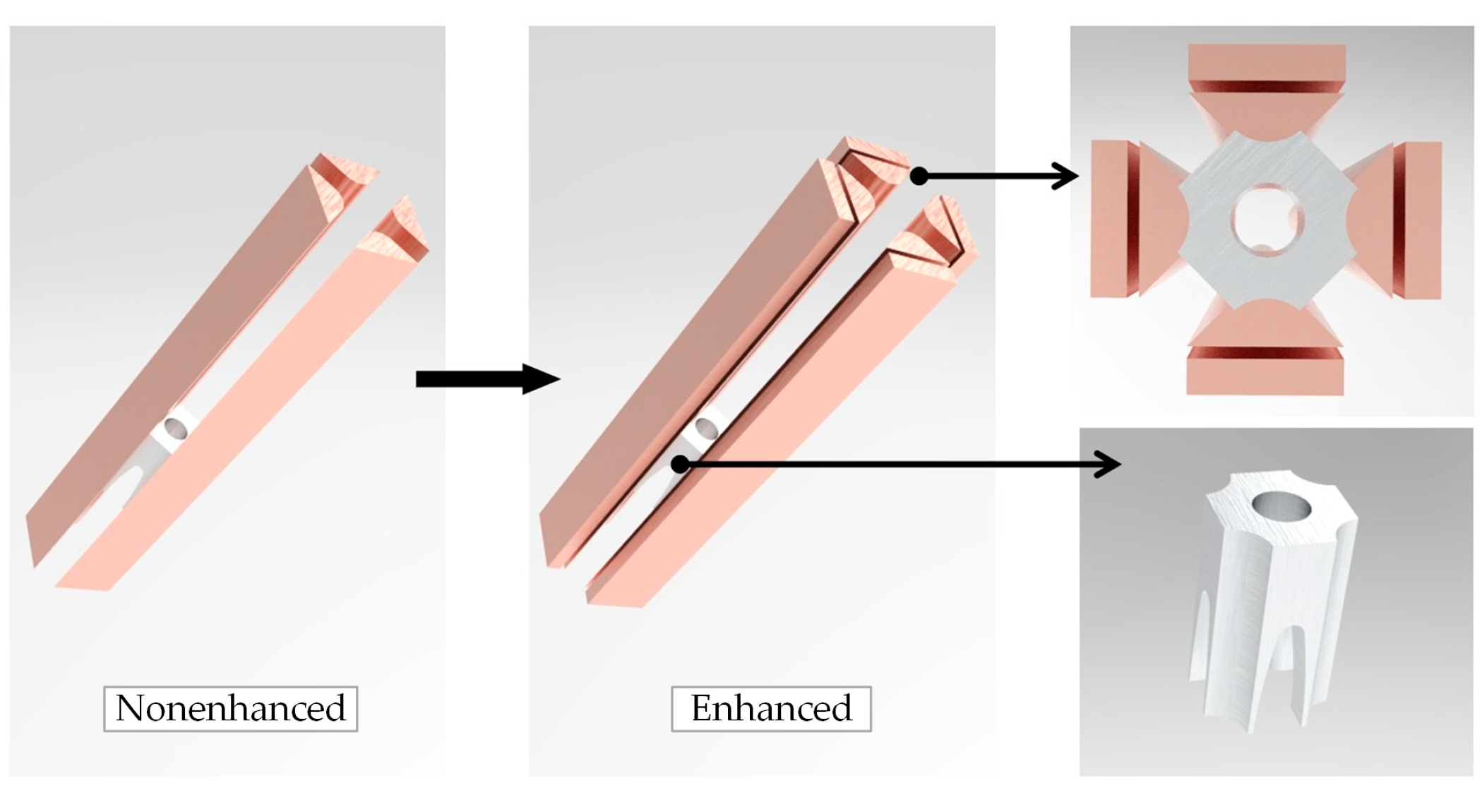


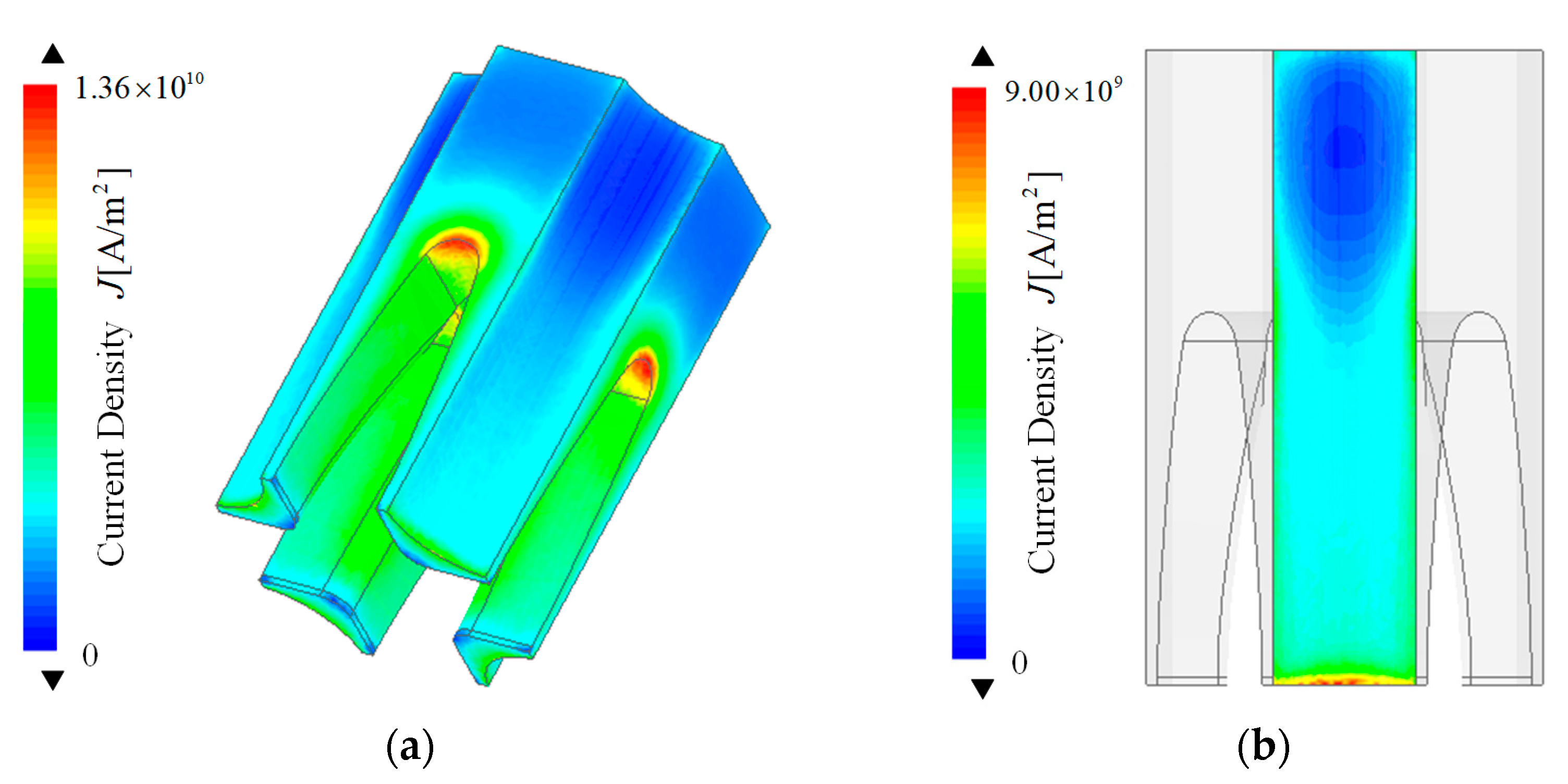

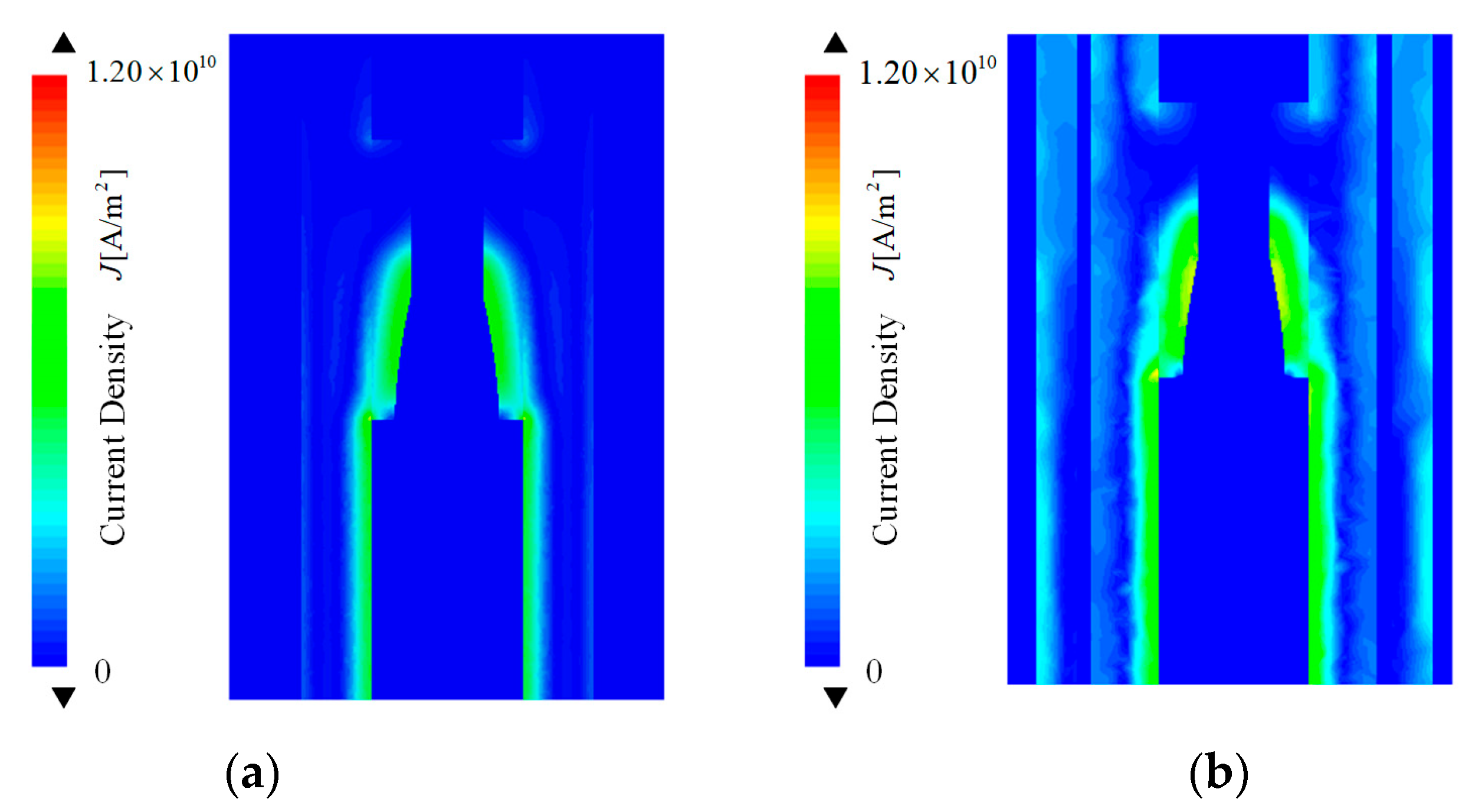
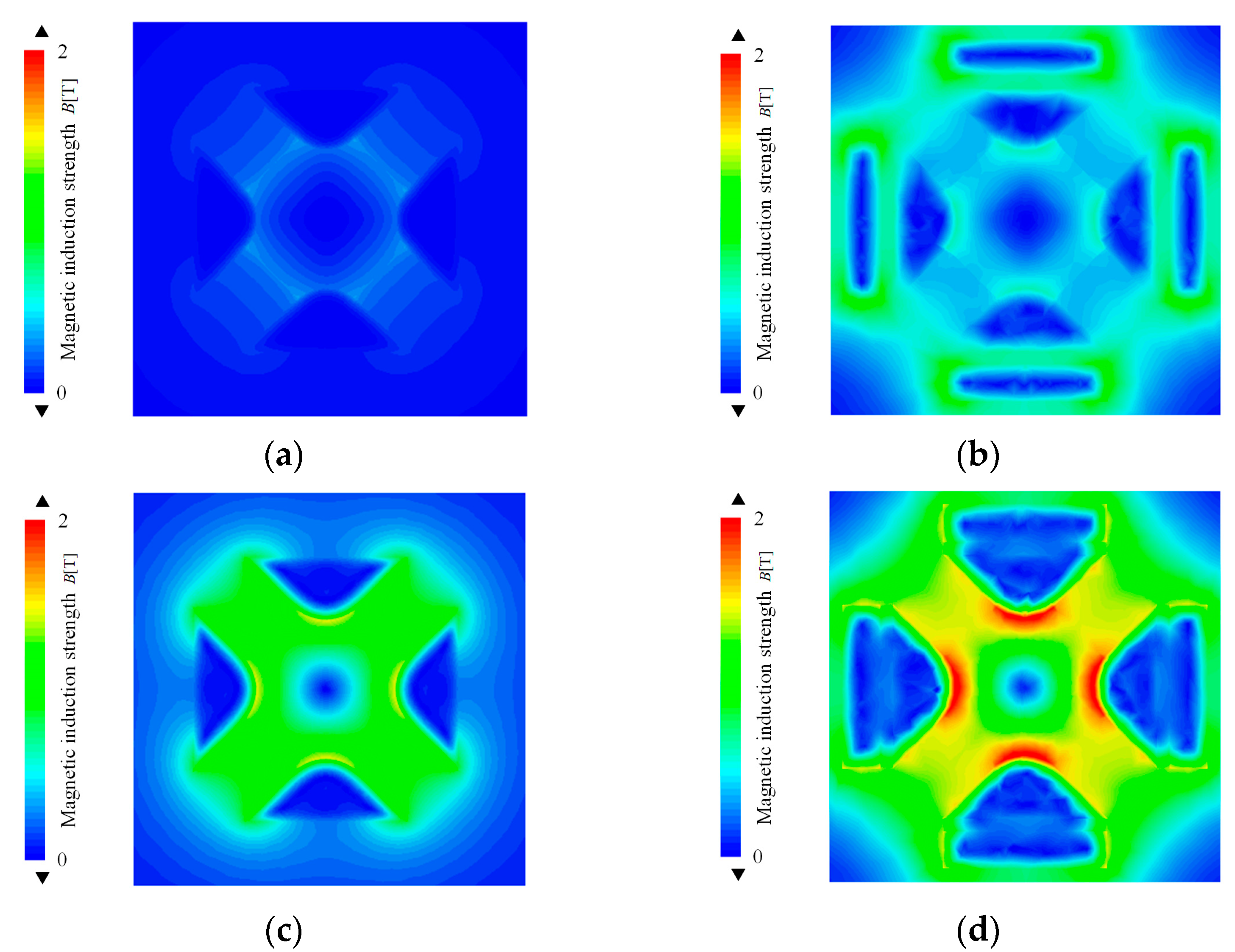
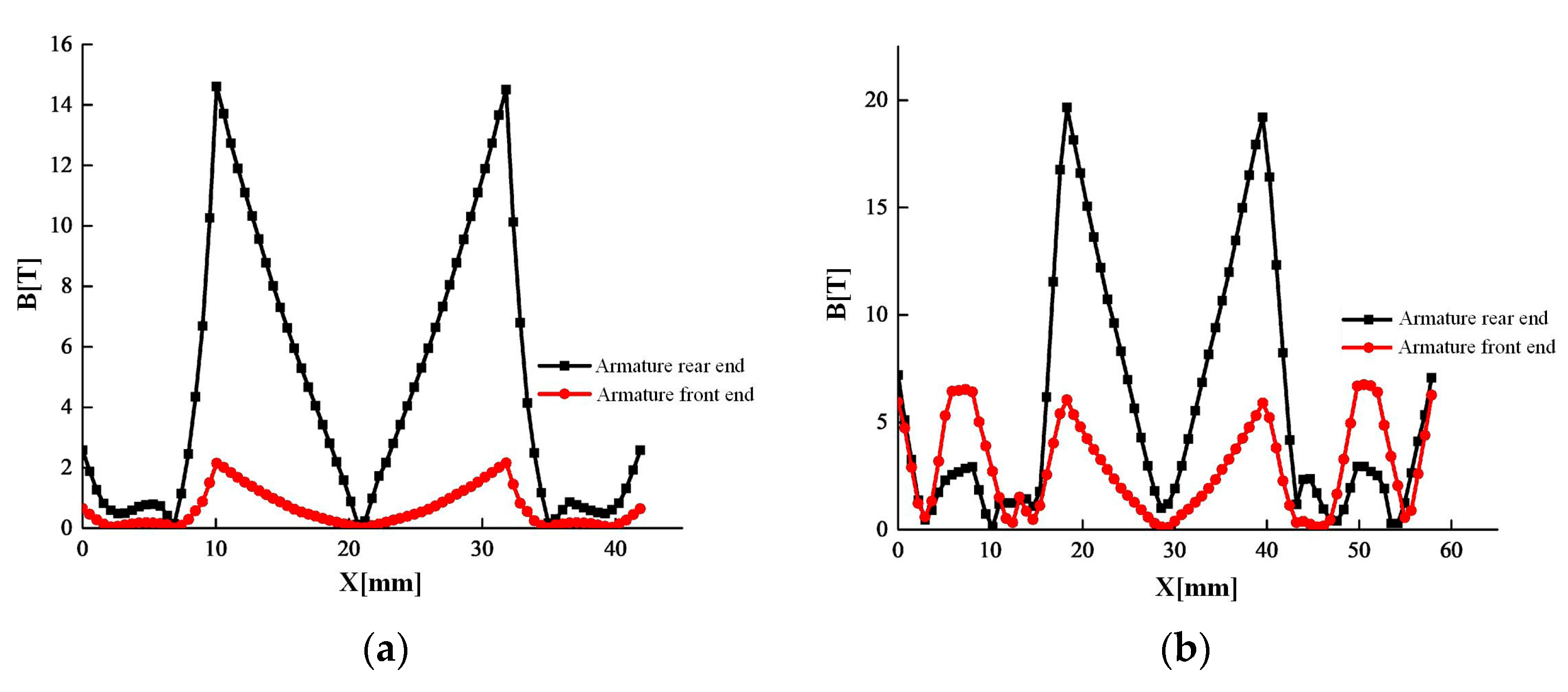


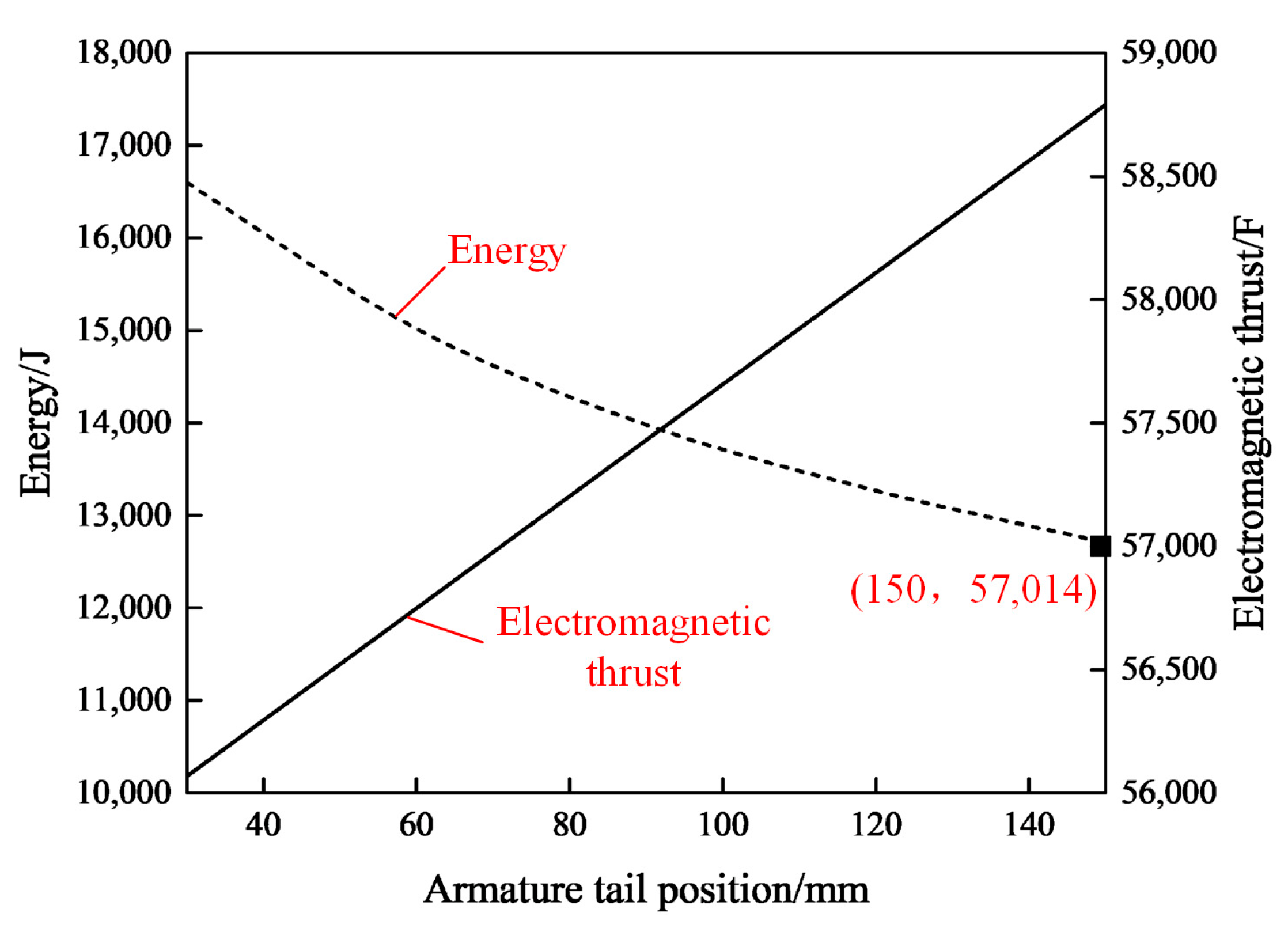
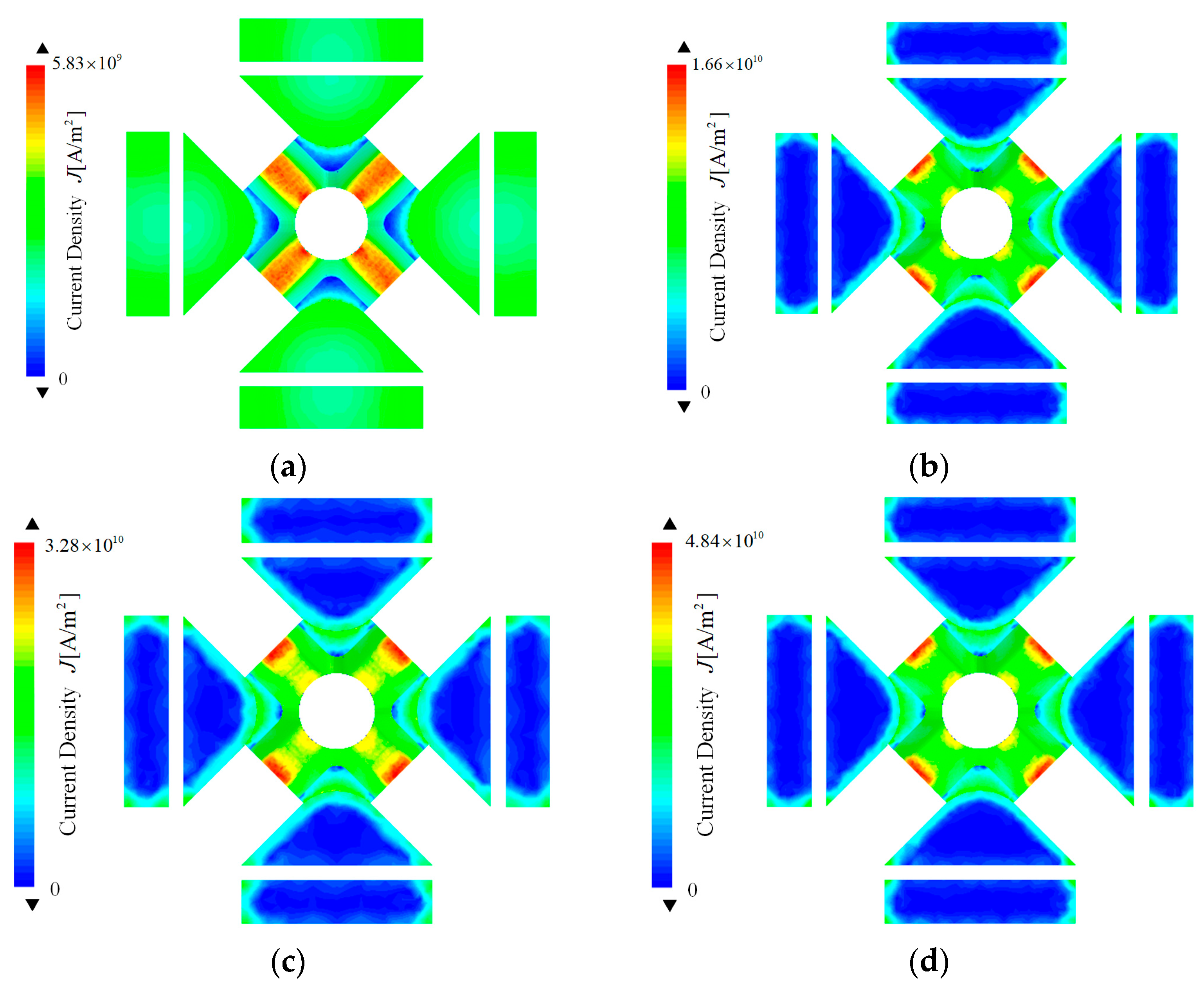
| Material | Density | Vacuum Permeability | Conductivity | Resistivity |
|---|---|---|---|---|
| Copper | ||||
| Aluminum |
| 57.86 | 26 | 6 | 2 | 10.07 |
| 7.07 | 8 | 217.3 | 40 | 6.855 |
| - | - | |||
| 5.175 | 1000 | 400 | - | - |
| Parameter | Configuration | Analytical Value | Simulation Value | Error Rate (%) |
|---|---|---|---|---|
| Electromagnetic force (N) | Nonenhanced | 26,962 | 27,116 | 0.57 |
| Enhanced | 57,918 | 58,474 | 0.95 | |
| Inductance gradient | Nonenhanced | 0.6741 | 0.703 | 4.11 |
| Enhanced | 1.4480 | 1.512 | 4.23 |
| Structure | Frequency (Hz) | Armature Tail Position (mm) | ||||
|---|---|---|---|---|---|---|
| 30 | 60 | 90 | 120 | 150 | ||
| Nonenhanced | 100 | 0.8024 | 0.8022 | 0.8002 | 0.7984 | 0.7981 |
| 1000 | 0.7079 | 0.7065 | 0.7035 | 0.6988 | 0.6865 | |
| 2000 | 0.6783 | 0.6653 | 0.6635 | 0.6613 | 0.6601 | |
| 3000 | 0.6658 | 0.6521 | 0.6485 | 0.6444 | 0.6249 | |
| 5000 | 0.6423 | 0.6396 | 0.6231 | 0.6199 | 0.6101 | |
| 10,000 | 0.6265 | 0.6223 | 0.6208 | 0.6158 | 0.6028 | |
| Enhanced | 100 | 1.785 | 1.7833 | 1.7825 | 1.7825 | 1.7825 |
| 1000 | 1.5201 | 1.5150 | 1.5125 | 1.5100 | 1.5108 | |
| 2000 | 1.4699 | 1.4600 | 1.4596 | 1.4592 | 1.4583 | |
| 3000 | 1.4416 | 1.4392 | 1.4391 | 1.4375 | 1.4367 | |
| 5000 | 1.4285 | 1.4182 | 1.4183 | 1.4175 | 1.4150 | |
| 10,000 | 1.4133 | 1.4000 | 1.3983 | 1.3930 | 1.3917 | |
Publisher’s Note: MDPI stays neutral with regard to jurisdictional claims in published maps and institutional affiliations. |
© 2022 by the authors. Licensee MDPI, Basel, Switzerland. This article is an open access article distributed under the terms and conditions of the Creative Commons Attribution (CC BY) license (https://creativecommons.org/licenses/by/4.0/).
Share and Cite
Ren, S.; Feng, G.; Zhang, P.; Li, T.; Zhao, X. Method of Calculating Inductance Gradient for Complex Electromagnetic Rail Launcher. Electronics 2022, 11, 2912. https://doi.org/10.3390/electronics11182912
Ren S, Feng G, Zhang P, Li T, Zhao X. Method of Calculating Inductance Gradient for Complex Electromagnetic Rail Launcher. Electronics. 2022; 11(18):2912. https://doi.org/10.3390/electronics11182912
Chicago/Turabian StyleRen, Shida, Gang Feng, Pengxiang Zhang, Tengda Li, and Xilai Zhao. 2022. "Method of Calculating Inductance Gradient for Complex Electromagnetic Rail Launcher" Electronics 11, no. 18: 2912. https://doi.org/10.3390/electronics11182912
APA StyleRen, S., Feng, G., Zhang, P., Li, T., & Zhao, X. (2022). Method of Calculating Inductance Gradient for Complex Electromagnetic Rail Launcher. Electronics, 11(18), 2912. https://doi.org/10.3390/electronics11182912






